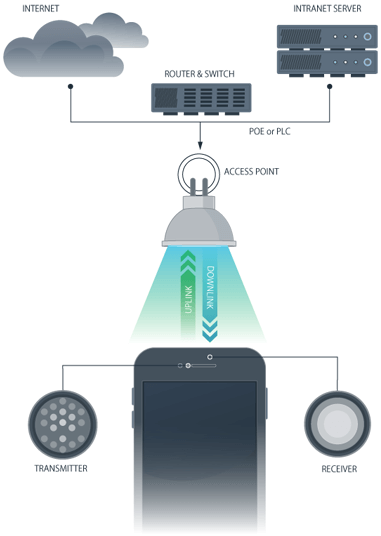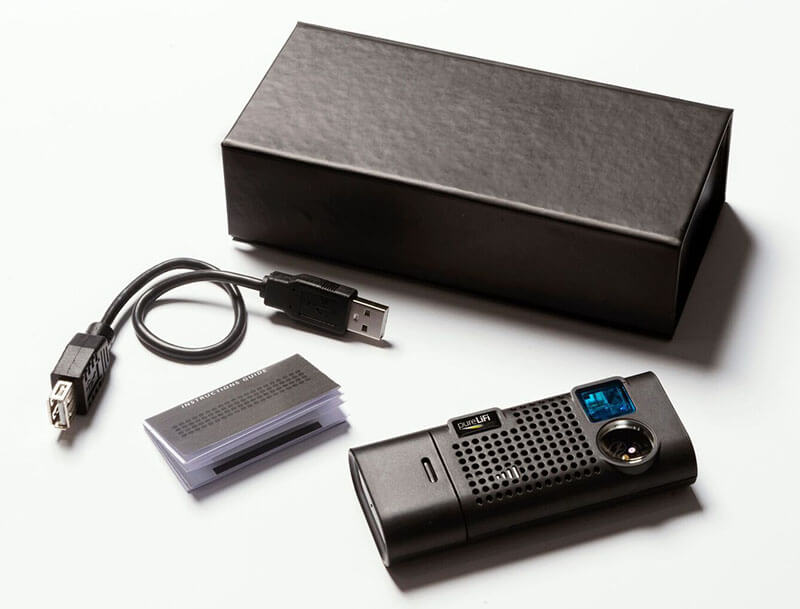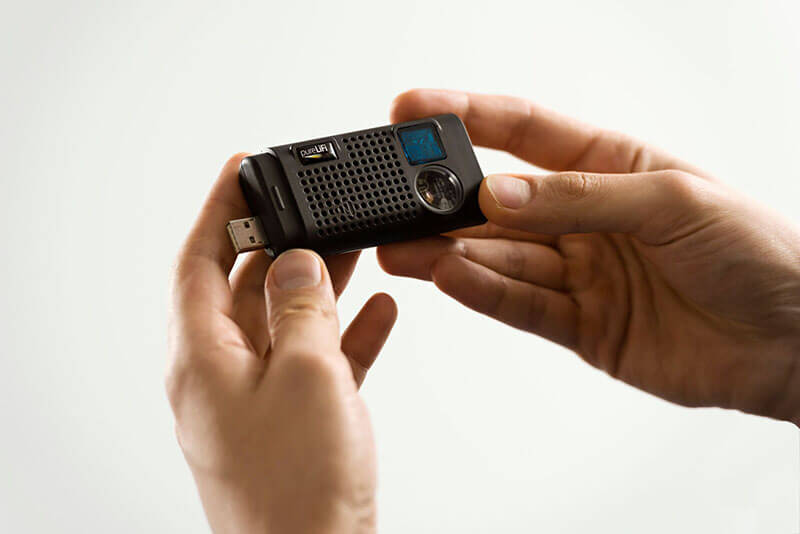Interview with CEO of pureLiFi, Alistair Banham
What is LiFi and how does it work? What are its main benefits over Wi-Fi or RF and how does it address security challenges? We interviewed Alistair Banham, CEO of pureliFi to understand how LiFi can enable wireless communication.

Alistair Banham, pureLiFi CEO
What is the need for LiFi?
Connectivity is evolving. The spectrum now has to accommodate more mobile users and a forecasted increase to 20 Billion IoT devices by the year 2020.
It is time to future proof our networks to enable the connectivity demands of tomorrow. With LiFi we can utilise spectrum more than 1000 times greater than the spectrum utilised for radio frequencies (RF). LiFi is now unlocking unprecedented data and bandwidth.
Imagine every LED light in our offices, buildings and cities could become a high speed, smart, and secure internet access point. LiFi is a high speed, bi-directional, fully networked and mobile communication of data, using light.
How Does LiFi Work?
When an electrical current is applied to a LED light bulb, a stream of light (photons) is emitted from the bulb. LED bulbs are semiconductor devices, which means that the brightness of the light flowing through them can be changed at extremely high speeds. This allows us to send a signal by modulating the light at different rates. The signal can then be received by a detector which interprets the changes in light intensity (the signal) as data.
The intensity modulation cannot be seen by the human eye, and thus communication is just as seamless as other radio systems, allowing the users to be connected where there is LiFi enabled light. Using this technique, data can be transmitted from an LED light bulb and back to an infrared (IR) receiver at high speeds.

Who invented the concept of LiFi and why?
Prof Harald Haas foresaw that the digital revolution would result in a requirement for greater spectrum to service our ever-growing demand for connectivity. This inspired him to experiment with utilising the light spectrum to unleash high-speed data communications.
Haas’s predictions have become even more evident in recent years. Significant wireless traffic was off loaded onto the fixed networks through Wi-Fi or femtocell in 2016. In total, 10.7 exabytes of mobile data traffic was off loaded onto the fixed network each month. (Cisco Visual Networking Index: Global Mobile Data Traffic Forecast Update, 2016–2021 White Paper, 2017) If mobile data traffic continues to increase as expected, the world will run out of RF spectrum before 2025. It is important to our continued connectivity that we start to adopt new wireless communications technologies today such as LiFi.
LiFi isn’t an entirely new concept. Light communications were initially conceptualised by Alexander Graham bell in 1880 when he invented the photophone. The photophone was a telecommunications device that allowed for the transmission of speech on a beam of light. Just over 130 years later Prof Harald Haas demonstrated data communication using the Light spectrum at Ted Global in 2011 and coined the term LiFi.
It’s only been five years since pureLiFi demonstrated the first commercially available LiFi system: what's happened since then? How quickly is LiFi being deployed in real-world applications?
pureLiFi spun out of the University of Edinburgh in January 2012 and since then the company has raised over 10 million (USD) in funding to support LiFi technology development and adoption. Since the company formed, we have released three generations of the LiFi products that have been deployed in more than 14 countries that have executed more than 11 different use cases including secure wireless environments, enterprise office solutions, wireless communications in RF hostile zones and even underwater communications.

pureLiFi Dongle Package
Is it an indoor solution only or can it be used outdoors (now or in future)? How does it work at night and in bright sunlight?
Eighty percent of wireless data is consumed indoors which is why LiFi adoption has started within indoor, office and industrial environments. However, LiFi can operate in daylight, dark room conditions and even in direct sunlight conditions, as the modulated light can still be detected. LiFi relies on detecting the fast changes in light intensity and not on the absolute or slowly varying levels caused by natural disruptions in daylight or sunlight. It is highly likely that streetlights or street furniture of the future will also provide high-speed, secure wireless communications, enabling public LiFi hotspots and powering smart transport, cities and nations.
Can you outline the main benefits of LiFi over Wi-Fi or other RF technologies?
There are five key areas where LiFi can provide significant benefits.
Congestion
Wi-Fi uses radio frequencies, and these are very limited. Devices computers, laptops, printers, smart TVs, smartphones and tablets must compete for bandwidth. The emergence of more and more Wi-Fi-enabled things e.g. refrigerators, watches, cameras, and offloading from cellular is causing congestion and degrading data communications. LiFi uses the frequencies of light waves, which are 1000 times more plentiful than radio frequencies and do not interfere with radio frequencies.
Density
Imagine an office of 460 sq metres with 80 employees working on tablets and laptops wirelessly. Typically for every 200 square meters, there would be one wireless Wi-Fi router providing approximately 1 Gbps. This would mean there would be a total of 2 Gbps for the entire office to share. However, imagine that the entire lighting structure of the office was LiFi enabled. Even if conservatively the office only had 100 lights in the ceiling that would provide more than 4 Gbps (at today’s pureLiFi product’s data rates) for the office to share and if that’s not enough all you have to do is add more lights. However, you can’t add more Wi-Fi routers as they interfere with each other. The amount of available data per square metre of space in a room will always be greater with LiFi.
Security
Radio waves pass through walls and ceilings. Light doesn't. Therein lies the difference in data security between Wi-Fi and LiFi. An intruder or hacker, outside a building, can tap into the Wi-Fi data communications of computers inside the building. Data communicated via LiFi can only be accessed where the LED light illuminates.
Safety
Wi-Fi creates Electromagnetic Interference (EMI), known to interfere with aeroplanes' instruments and equipment in hospitals, and is potentially dangerous in hazardous operations, such as power/nuclear generation or oil and gas drilling. LiFi uses light instead of radio waves, which is intrinsically safe and does not create EMI.
Speed
The older versions of the Wi-Fi standard, like IEEE 802.11a/g, specify data rates up to 54Mbps. However, the newer Wi-Fi standards, like the 802.11ac provide technologies that can extend these data rates to 1Gbps and beyond. Indeed, the 802.11ad can achieve data rates of up to 7 Gbps. The University of Edinburgh, pureLiFi’s partner and home to Prof. Harald Haas – “the father of LiFi”, have already demonstrated data rates in the gigabits per second (Gbps) region, showing great promise of this rapidly maturing technology.
What speeds can be achieved with LiFi today? How quickly will this increase?
Currently, pureLiFi’s systems provide 43Mbps full duplex communications, and offer much greater data density than other RF solutions. In lab conditions, our CSO (Chief Scientific Officer) Harald Haas has shown transmission data rates of 11Gbps from a single LED.
What are the biggest applications for LiFi? Do you envisage LiFi becoming a consumer product for networking at home or just for large scale industrial applications – Smart Factories, Transportation, Automotive, Healthcare etc?
Early adopters of LiFi have seen great benefit from LiFi’s inherent security and the ability to use LiFi in RF hostile zones such as powerplants, petrochemical plants and hospitals. Due to the data density advantages, along with security and location services, features, we are starting to see greater adoption in the enterprise office environment. We believe the applications for LiFi are limitless. Anywhere both light and data are required, LiFi can provide high-speed, secure and reliable wireless communications. LiFi technology will be as far reaching as the home consumer as the requirement for additional spectrum will become more pressing.) The potential for LiFi is so great there will be applications we haven't thought of yet.
How does LiFi address security challenges? Are they any different to Wi-Fi security modes? Is it secure?
pureLiFi is developing the security components and technologies that enable security specialists to deliver more secure wireless communications. LiFi is significantly more secure than other wireless technologies because light can be contained in a physical space. Our doors and blinds can be shut, and physical barriers and adjustments can be implemented to contain and protect the light. We can create the conditions that allow us to shut the door on our wireless data.
Existing security protocols for encryption and authentication can be leveraged in LiFi systems to provide even more secure wireless systems.
Does LiFi work alongside other communication modes or does it supersede them? Will it be the solution that overcomes challenges such as interference, ranges, throughput, power requirements?
LiFi is a technology that will open up 1000 times more spectrum for wireless communications. LiFi is also a complimentary and additive technology that works alongside other wireless technologies such as Wi-Fi and cellular. For example, If the light signal to a LiFi enabled device is below the receiver’s threshold such as when it’s in a user’s pocket, then it will not receive data. In that instance, radio systems or cellular networks, if available, will continue to deliver data. When the devices can be seen by the light again, the user can continue to enjoy LiFi.
How much does it cost? Can existing devices be enabled with LiFi – how much would that cost? Does it need big investment and time to implement a LiFi infrastructure – particularly with Wi-Fi being so prevalent?
pureLiFi is working with a broad range of companies in the communications and lighting ecosystem such as telecoms operators, switch and router companies, lighting innovators as well as, mobile and connected device manufacturers to provide integrated LiFi solutions. As LiFi technology matures the cost requirements to implement in mobile and lighting devices will follow a similar path as Wi-Fi technology. Many will remember Wi-Fi technology was once a dongle then became the integrated ubiquitous communications we know today. LiFi will share a similar evolution and be integrated into end-user products.

pureLiFi Dongle
Where and how does LiFi communication fits into IoT ecosystem?
LiFi can offer connectivity where ever there is light and a need for communication. LiFi can be integrated in everyday technology such as appliances, vehicles, manufacturing equipment and more into smart connected technology. LiFi provides another bearer for wireless communications and can be used to connect the last few meters of a complete IoT system to send and receive data.
Can LiFi be used for ultra-low power applications? How does its power consumption compare with other communications technologies?
LiFi provides communication using the same energy that is used for illumination. Due to this "reuse", the incremental energy needed by LiFi transmission can be very small. In addition, LiFi signals could potentially be received by solar cells that can harness energy from the ambient light. The combination of LiFi and solar cells can potentially create an entirely energy neutral communications system.
How can you start to develop a LiFi system? Do you sell chipsets and software?
Today, pureLiFi can provide businesses with LiFi systems to deploy LiFi networks. Our LiFi systems are comprised of both an access point (a light) and a dongle along with the necessary software to enable the solution. We also partner with lighting innovators to integrate our technology in their lighting units.
pureLiFi is driving the miniaturisation of LiFi technology. LiFi has the ability to be in every mobile device and LED in the future.
What are the building blocks of a LiFi system? Can you build a LiFi system using a microcontroller, LEDs and a photo detector? Or do you need specialist chips?
It is possible for developers to build rudimentary VLC systems using off the shelf components. However, that is not real LiFi. To develop real LiFi which is high speed, bi-directional and fully networked, developers require specialist knowledge and specialist components.
Can LiFi products from one manufacturer work with other manufacturers systems? Is there good interoperability?
At the moment pureLiFi’s technology is only interoperable with our partner's technology. For example, our LiFi-X dongle is interoperable with the Lucibel Ores Luminaire. Indeed, there are currently no LiFi products from different technology suppliers that are interoperable.
pureLiFi is addressing this through standardisation with interoperability by supporting the creation of a wide-ranging ecosystem of partners from the chipset and switch suppliers through to device integrators, lighting companies and end users.
Standardisation is progressing under the 802.11 IEEE body which recently started the Light Communications Study Group and is the same group that standardizes Wi-Fi. We hope that these standardization efforts will contribute to the eventual interoperability as an integral part of 5G.
Interview with CEO of pureLiFi, Alistair Banham. Date published: 22nd September 2017 by Farnell element14